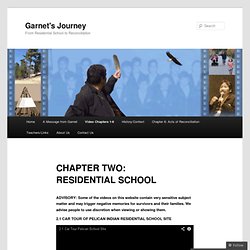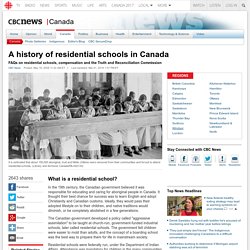

CHAPTER TWO: RESIDENTIAL SCHOOL. ADVISORY: Some of the videos on this website contain very sensitive subject matter and may trigger negative memories for survivors and their families.

We advise people to use discretion when viewing or showing them. Garnet Angeconeb attended Pelican Indian Residential School from age seven to twelve — 1963 to 1969. The original residential school was unceremoniously torn down in 1978. The site is now home to a high school for Anishnaabe students from northern First Nations communities. In this segment, Garnet shares his feelings about the physical place as he tours the site in 2011. Garnet attended Pelican Indian Residential School for six years — from September of 1963 to June of 1969 — from age 7 to 12. Lawsuit claiming loss of aboriginal cultural identity due to '60's scoop' to go ahead. TORONTO -- A class action lawsuit which claims a loss of cultural identity was suffered by aboriginal children adopted into non-indigenous homes during the so called "60's Scoop" was given the green light to proceed by an Ontario court on Tuesday.

The case -- which focuses on a period between the 1960s and the 1980s when thousands of aboriginal children were taken from their homes and placed with non-native families -- is being flagged by the plaintiffs' lawyer as a landmark suit against the federal government. "This is the first case in the Western world where indigenous persons have come forward and said that our culture is as important as our land claims, fishing rights and hunting rights," said Jeffery Wilson.
"Where they were placed, Canada then turned a blind eye to preserving and protecting their culture. So we essentially lost a generation of aboriginal children who feel detached. " "The name I use now...it's not my name," she said in angry, measured tones. To kill the Indian in the Child. The Painful Legacy. Personal Experiences (Blog)
Looking into Jesus. CBC News Loss of Aboriginal culture. What is a residential school?

In the 19th century, the Canadian government believed it was responsible for educating and caring for aboriginal people in Canada. It thought their best chance for success was to learn English and adopt Christianity and Canadian customs. Ideally, they would pass their adopted lifestyle on to their children, and native traditions would diminish, or be completely abolished in a few generations. The Canadian government developed a policy called "aggressive assimilation" to be taught at church-run, government-funded industrial schools, later called residential schools. The government felt children were easier to mold than adults, and the concept of a boarding school was the best way to prepare them for life in mainstream society.
Residential schools were federally run, under the Department of Indian Affairs. How many residential schools and students were there? Initially, about 1,100 students attended 69 schools across the country. What went wrong? Wikipedia Residential schools. There has long been significant historiographical and popular controversy about the conditions experienced by students in the residential schools.

While day schools for First Nations, Metis and Inuit children always far outnumbered residential schools, a new consensus emerged in the early 21st century that the latter schools did significant harm to Aboriginal children who attended them by removing them from their families, depriving them of their ancestral languages, sterilization, and exposing many of them to physical and sexual abuse at the hands of staff and other students, and enfranchising them forcibly. History[edit] The foundations of the system were the pre-confederation Gradual Civilization Act (1857) and the Gradual Enfranchisement Act (1869). These assumed the inherent superiority of British ways, and the need for Indians to become English-speakers, Christians, and farmers. At the time, many Aboriginal leaders wanted these acts overturned.[9] St. Mortality rates[edit] Fallen Feather-Young Children Converted. Aboriginals these days.